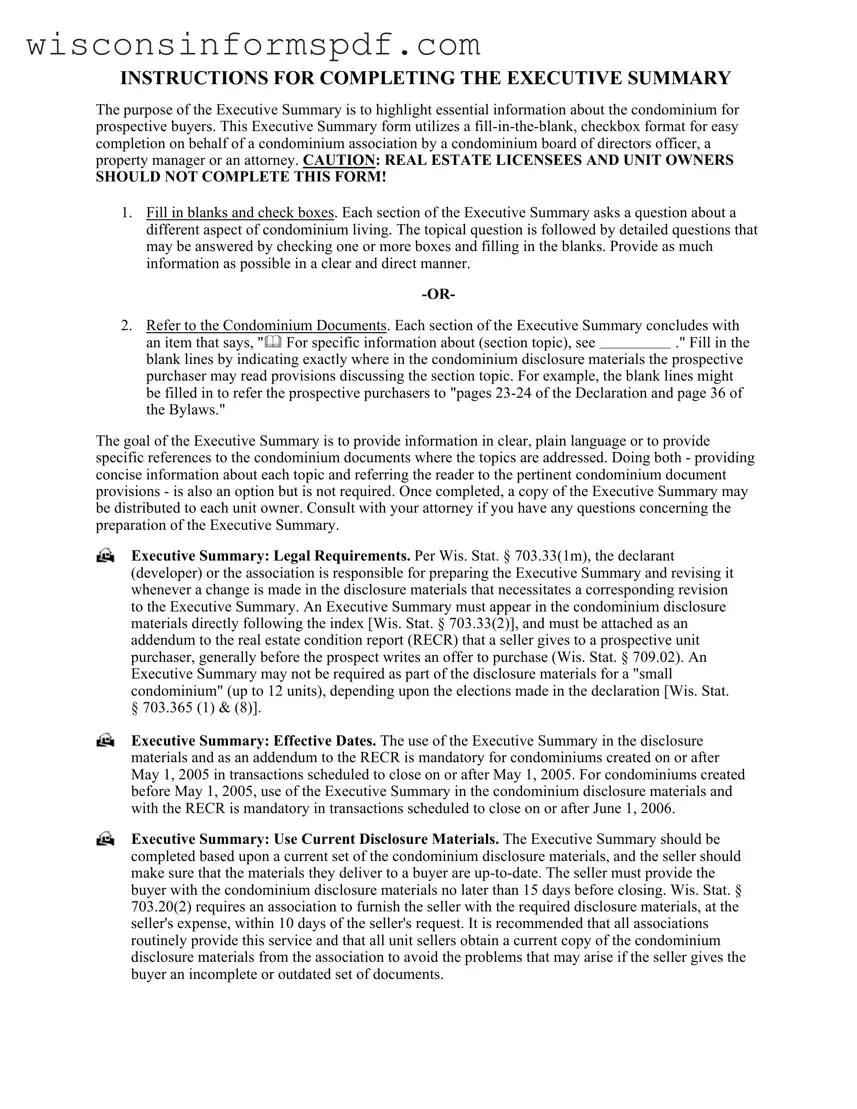INSTRUCTIONS FOR COMPLETING THE EXECUTIVE SUMMARY
The purpose of the Executive Summary is to highlight essential information about the condominium for prospective buyers. This Executive Summary form utilizes a fill-in-the-blank, checkbox format for easy completion on behalf of a condominium association by a condominium board of directors officer, a property manager or an attorney. CAUTION: REAL ESTATE LICENSEES AND UNIT OWNERS
SHOULD NOT COMPLETE THIS FORM!
1.Fill in blanks and check boxes. Each section of the Executive Summary asks a question about a different aspect of condominium living. The topical question is followed by detailed questions that may be answered by checking one or more boxes and filling in the blanks. Provide as much information as possible in a clear and direct manner.
-OR-
2. Refer to the Condominium Documents. Each section of the Executive Summary concludes with
an item that says, " For specific information about (section topic), see ." Fill in the blank lines by indicating exactly where in the condominium disclosure materials the prospective purchaser may read provisions discussing the section topic. For example, the blank lines might be filled in to refer the prospective purchasers to "pages 23-24 of the Declaration and page 36 of the Bylaws."
The goal of the Executive Summary is to provide information in clear, plain language or to provide specific references to the condominium documents where the topics are addressed. Doing both - providing concise information about each topic and referring the reader to the pertinent condominium document provisions - is also an option but is not required. Once completed, a copy of the Executive Summary may be distributed to each unit owner. Consult with your attorney if you have any questions concerning the preparation of the Executive Summary.
Executive Summary: Legal Requirements. Per Wis. Stat. § 703.33(1m), the declarant (developer) or the association is responsible for preparing the Executive Summary and revising it whenever a change is made in the disclosure materials that necessitates a corresponding revision to the Executive Summary. An Executive Summary must appear in the condominium disclosure materials directly following the index [Wis. Stat. § 703.33(2)], and must be attached as an addendum to the real estate condition report (RECR) that a seller gives to a prospective unit purchaser, generally before the prospect writes an offer to purchase (Wis. Stat. § 709.02). An Executive Summary may not be required as part of the disclosure materials for a "small condominium" (up to 12 units), depending upon the elections made in the declaration [Wis. Stat. § 703.365 (1) & (8)].
Executive Summary: Effective Dates. The use of the Executive Summary in the disclosure materials and as an addendum to the RECR is mandatory for condominiums created on or after May 1, 2005 in transactions scheduled to close on or after May 1, 2005. For condominiums created before May 1, 2005, use of the Executive Summary in the condominium disclosure materials and with the RECR is mandatory in transactions scheduled to close on or after June 1, 2006.
Executive Summary: Use Current Disclosure Materials. The Executive Summary should be completed based upon a current set of the condominium disclosure materials, and the seller should make sure that the materials they deliver to a buyer are up-to-date. The seller must provide the buyer with the condominium disclosure materials no later than 15 days before closing. Wis. Stat. § 703.20(2) requires an association to furnish the seller with the required disclosure materials, at the seller's expense, within 10 days of the seller's request. It is recommended that all associations routinely provide this service and that all unit sellers obtain a current copy of the condominium disclosure materials from the association to avoid the problems that may arise if the seller gives the buyer an incomplete or outdated set of documents.

This Executive Summary highlights some of the information that prospective condominium buyers are most interested in learning, as well as some of the information that they should consider when contemplating the purchase of a condominium unit. The following sections either briefly summarize pertinent information by answering the questions asked, direct prospective buyers to specific sections of the condominium disclosure materials that discuss each topic in detail (at the icon), or may be completed to both summarize the information and refer to the condominium documents. This summary, however, is not intended to replace the buyer's review of the condominium declaration, bylaws and other condominium disclosure materials nor is it a substitute for a professional review of the condominium documents.
|
|
|
|
Condominium Name: |
|
|
How is the condominium association managed? |
|
What is the name of the condominium association? |
|
What is the association's mailing address? |
|
How is the association managed? |
By the unit owners (self-managed) |
By a management agent or |
company |
By the declarant (developer) or the declarant's management company |
 Whom should I contact for more information about the condominium and the association?
Whom should I contact for more information about the condominium and the association?
(management agent/company or other available contact person)
 What is the address, phone number, fax number, web site & e-mail address for association management or the contact person?
What is the address, phone number, fax number, web site & e-mail address for association management or the contact person?
For specific information about the management of this association, see
What are the parking arrangements at this condominium? |
|
|
|
|
Number of parking spaces assigned to each unit: |
|
|
|
How many Outside? |
|
|
How many Inside? |
|
Common element |
Limited common element |
|
|
Included as part of the unit |
|
Separate non- |
voting units |
|
Depends on individual transaction |
[check all that apply] |
|
|
|
|
Do I have to pay any extra parking fees (include separate maintenance charges, if any)? |
No |
Yes, in |
the amount of $ |
|
|
|
per |
|
|
|
Other (specify): |
|
|
|
|
|
Are parking assignments reserved or designated on the plat or in the condominium documents? |
|
|
No |
Yes - Where? |
|
|
|
|
|
|
|
|
Are parking spaces assigned to a |
unit by deed? |
No |
Yes Can parking spaces be transferred between unit owners? |
No |
Yes |
What parking is available for visitors? |
|
|
|
|
|
|
|
|
|
|
|
What are the parking restrictions at this condominium? |
|
|
|
|
|
For specific information about parking at this condominium, see
May I have any pets at this condominium?
No |
Yes - What kinds of pets are allowed? |
 What are some of the major restrictions and limitations on pets?
What are some of the major restrictions and limitations on pets?
For specific information about the condominium pet rules, see
Unit owner assessments
May I rent my condominium unit?
No 
 Yes - What are the major limitations and restrictions on unit rentals?
Yes - What are the major limitations and restrictions on unit rentals?
For specific information about renting units at this condominium, see
Does this condominium have any special amenities and features?
No 
 Yes - What are the major amenities and features?
Yes - What are the major amenities and features?
 Are unit owners obligated to join or make additional payments for any amenity associated with the
Are unit owners obligated to join or make additional payments for any amenity associated with the
condominium, such as an athletic club or golf course? |
No |
Yes - What is the cost? $ |
For specific information about special amenities, see
What are my maintenance and repair responsibilities for my unit?
 A Unit Owner must maintain and repair
A Unit Owner must maintain and repair
For specific information about unit maintenance and repairs, see
Who is responsible for maintaining, repairing and replacing the common elements and limited common elements?
 Common element maintenance, repair and replacement is performed as follows:
Common element maintenance, repair and replacement is performed as follows:
How are repairs and replacements of the common elements funded? |
Unit owner assessments Reserve |
funds |
Both |
Other (specify): |
|
|
 Limited common element maintenance, repairs and replacement is performed as follows:
Limited common element maintenance, repairs and replacement is performed as follows:
 How are repairs and replacements of the limited common elements funded?
How are repairs and replacements of the limited common elements funded?
Reserve funds |
Both |
Other (specify): |
For specific information about common element maintenance, repairs and replacements see
Does the condominium association maintain reserve funds for the repair and replacement of the common elements? 
 Yes
Yes 
 No Is there a Statutory Reserve Account (*see note on page 3*)?
No Is there a Statutory Reserve Account (*see note on page 3*)? 
 Yes
Yes 
 No
No
For specific information about this condominium's reserve funds for repairs and replacements, see
How are condominium fees paid for on the developer's new units that have not yet been sold to a purchaser?
 Is the developer's obligation to pay fees for unsold units different than the obligation of new unit purchasers to pay fees on their units?
Is the developer's obligation to pay fees for unsold units different than the obligation of new unit purchasers to pay fees on their units? 
 Not applicable (no developer-owned units)
Not applicable (no developer-owned units) 
 No
No 
 Yes - In what way?
Yes - In what way?

Page 3 of 3
 Are there any special provisions for the payment of assessment fees that apply only during the developer control period?
Are there any special provisions for the payment of assessment fees that apply only during the developer control period? 
 No
No 
 Yes - Describe these provisions:
Yes - Describe these provisions:
For specific information about condominium fees during the developer control period, see
Has the declarant (developer) reserved the right to expand this condominium in the future?


 No
No 
 Yes - How many additional units may be added through expansion?units
Yes - How many additional units may be added through expansion?units  When does the expansion period end?
When does the expansion period end?
 Who will manage the condominium during the expansion period?
Who will manage the condominium during the expansion period?
For specific information about condominium expansion plans, see
May I alter my unit or enclose any limited common elements?
 Describe the rules, restrictions and procedures for altering a unit:
Describe the rules, restrictions and procedures for altering a unit:
 Describe the rules, restrictions and procedures for enclosing limited common elements:
Describe the rules, restrictions and procedures for enclosing limited common elements:
For specific information about unit alterations and limited common element enclosures, see
Can any of the condominium materials be amended in a way that might affect my rights and responsibilities?
 Yes, Wisconsin law allows the unit owners to amend the condominium declaration, bylaws and other condominium documents if the required votes are obtained. Some of these changes may alter your legal rights and responsibilities with regard to your condominium unit.
Yes, Wisconsin law allows the unit owners to amend the condominium declaration, bylaws and other condominium documents if the required votes are obtained. Some of these changes may alter your legal rights and responsibilities with regard to your condominium unit.
For specific information about condominium document amendment procedures and requirements, see
Other restrictions or features (optional):
This Executive Summary was prepared on |
|
|
(insert date) |
by |
|
|
(state name and title or position). |
*Note: A "Statutory Reserve Account" is a specific type of reserve account established under Wis. Stat. § 703.163 to be used for the repair and replacement of the common elements in a residential condominium (optional for a small condominium with less than 13 units or a mixed-use condominium with residential and non-residential units). In a new condominium, the developer initially decides whether to have a statutory reserve account, but after the declarant control period ends, the association may opt-in or opt-out of a statutory reserve account with the written consent of a majority of the unit votes. Existing condominiums must establish a statutory reserve account by May 1, 2006 unless the association elects to not establish the account by the written consent of a majority of the unit votes. Condominiums may also have other reserve fund accounts used for the repair and replacement of the common elements that operate apart from §703.165.
This Executive Summary was developed and distributed by the Wisconsin REALTORS® Association (2004).
Drafted by: Attorneys Debra Peterson Conrad (WRA), Jonathan B. Levine, and Lisa M. Pardon (Brennan, Steil & Basting, S.C.)



 Whom should I contact for more information about the condominium and the association?
Whom should I contact for more information about the condominium and the association? What is the address, phone number, fax number, web site &
What is the address, phone number, fax number, web site &  What are some of the major restrictions and limitations on pets?
What are some of the major restrictions and limitations on pets?

 Yes - What are the major limitations and restrictions on unit rentals?
Yes - What are the major limitations and restrictions on unit rentals?
 Yes - What are the major amenities and features?
Yes - What are the major amenities and features? Are unit owners obligated to join or make additional payments for any amenity associated with the
Are unit owners obligated to join or make additional payments for any amenity associated with the A Unit Owner must maintain and repair
A Unit Owner must maintain and repair Common element maintenance, repair and replacement is performed as follows:
Common element maintenance, repair and replacement is performed as follows: Limited common element maintenance, repairs and replacement is performed as follows:
Limited common element maintenance, repairs and replacement is performed as follows: How are repairs and replacements of the limited common elements funded?
How are repairs and replacements of the limited common elements funded?







 Is the developer's obligation to pay fees for unsold units different than the obligation of new unit purchasers to pay fees on their units?
Is the developer's obligation to pay fees for unsold units different than the obligation of new unit purchasers to pay fees on their units? 
 Not applicable (no
Not applicable (no 
 No
No 
 Yes - In what way?
Yes - In what way?
 Are there any special provisions for the payment of assessment fees that apply only during the developer control period?
Are there any special provisions for the payment of assessment fees that apply only during the developer control period? 
 No
No 
 Yes - Describe these provisions:
Yes - Describe these provisions:

 No
No 
 Yes - How many additional units may be added through expansion?
Yes - How many additional units may be added through expansion? When does the expansion period end?
When does the expansion period end? Who will manage the condominium during the expansion period?
Who will manage the condominium during the expansion period? Describe the rules, restrictions and procedures for altering a unit:
Describe the rules, restrictions and procedures for altering a unit: Describe the rules, restrictions and procedures for enclosing limited common elements:
Describe the rules, restrictions and procedures for enclosing limited common elements: Yes, Wisconsin law allows the unit owners to amend the condominium declaration, bylaws and other condominium documents if the required votes are obtained. Some of these changes may alter your legal rights and responsibilities with regard to your condominium unit.
Yes, Wisconsin law allows the unit owners to amend the condominium declaration, bylaws and other condominium documents if the required votes are obtained. Some of these changes may alter your legal rights and responsibilities with regard to your condominium unit.